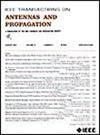All-Metallic-Metasurface-Based Wideband Dual Fabry–Perot Resonance Antenna Array With High Directivity and Polarization Purity
IF 5.8
1区 计算机科学
Q1 ENGINEERING, ELECTRICAL & ELECTRONIC
引用次数: 0
Abstract
In recent years, the integration of metasurface concepts into antenna design has sparked a revolutionary breakthrough, yielding unprecedented advancements in directivity, bandwidth, radiation pattern, polarization, and beam shaping capabilities once thought unachievable. However, further enhancements are still necessary, particularly in terms of integrability and loss reduction, while simultaneously broadening the operational bandwidth and enhancing gain and directivity. In this work, we demonstrate that incorporating the gap-waveguide (GW) technology into the radiator section can be leveraged to improve bandwidth and directivity of antenna arrays, mimicking a dual perfect electric conductor–perfect magnetic conductor (PMC) Fabry–Perot (FP) resonant cavity. Importantly, our concept comprises an entirely metallic高指向性和极化纯度的全金属超表面宽带双法布里-珀罗谐振天线阵列
近年来,将超表面概念集成到天线设计中引发了革命性的突破,在指向性、带宽、辐射方向图、极化和波束整形能力方面取得了前所未有的进步,这些能力曾经被认为是不可实现的。然而,进一步的改进仍然是必要的,特别是在可积性和降低损耗方面,同时扩大操作带宽,提高增益和指向性。在这项工作中,我们证明了将间隙波导(GW)技术结合到散热器部分可以用来提高天线阵列的带宽和指向性,模拟双完美电导体-完美磁导体(PMC)法布里-佩罗(FP)谐振腔。重要的是,我们的概念包括一个完全金属的$4 \ × 4$基于元表面的天线阵列,与之前在元表面设计中使用介电元件的研究不同。结果,测量带宽约为21% (12-14.8 GHz),测量增益高达22.9 dBi。此外,我们在馈电层实现了GW技术,通过插槽直接耦合到辐射层,从而优化了占地面积。
本文章由计算机程序翻译,如有差异,请以英文原文为准。
求助全文
约1分钟内获得全文
求助全文
来源期刊
CiteScore
10.40
自引率
28.10%
发文量
968
审稿时长
4.7 months
期刊介绍:
IEEE Transactions on Antennas and Propagation includes theoretical and experimental advances in antennas, including design and development, and in the propagation of electromagnetic waves, including scattering, diffraction, and interaction with continuous media; and applications pertaining to antennas and propagation, such as remote sensing, applied optics, and millimeter and submillimeter wave techniques

 求助内容:
求助内容: 应助结果提醒方式:
应助结果提醒方式:


